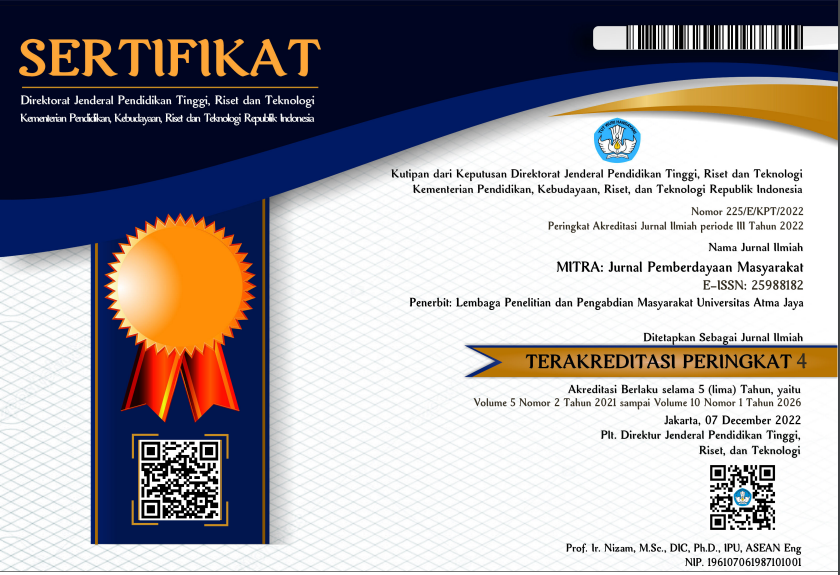Instilling Clean and Healthy Life Behavior in Paud Atmabrata, Cilincing, Jakarta
DOI:
https://doi.org/10.25170/mitra.v3i1.499Keywords:
clean living, healthy living, hand washing, healthy foodAbstract
This community service program is motivated by environmental problems in the Cilincing area of North Jakarta. There are many school-aged children who enjoy playing in an unhealthy environment that might affect their health at their young age. This unawareness can be overcome by instilling in them clean and healthy lifestyle. The purpose of the clean and healthy lifestyle program implemented in Atmabrata PAUD, Cilincing, was to make the students aware of healthy living from an early age. The program included 7-step hand washing training, familiarizing children to wash their hands, and consuming healthy food. The method was implemented by story-telling, question and answer, and demonstrations. The results showed that for hand washing activities 85% of students could do it according to the 7 steps of hand washing that had been simulated and demonstrated. As for consuming healthy food, 90% of students enjoyed healthy food and bought it. It can concluded that the increasing awareness of clean and healthy living behaviors can be determined by looking at whether or not students washed their hands in accordance with the steps described. Students also looked excited in eating healthy food and buying it. It is hoped that if a clean and healthy lifestyle such as washing hands and eating healthy food has become a habit, students will be able to apply it on a daily basis and pass it on to their friends. We suggest that if the program is continued, it needs to have further monitoring to examine whether students are still implementing clean and healthy living behaviors at school. We hope that in our next community service program we will be able to train students how to maintain personal hygiene, cleanliness of their home environment, and cleanliness of public environment.
References
Gunarti, W., Suryani, L.,& Muis, A. (2010). Metode pengembangan perilaku dan kemampuan dasar anak usia dini. Jakarta: Universitas Terbuka.
Hadini, I. & Puspitasari, D. (2012). Strategi pembelajaran terpadu: Teori, konsep, dan implementasi. Yogyakarta: Familia.
Moeslichatoen, R. (2004). Metode pengajaran di Taman Kanak – Kanak. Jakarta: PT Asdi Mahasatya. Raharji, A. (2014). Perilaku hidup bersih dan sehat (PHBS). Makalah disampaikan pada Persiapan Lomba PHBS. https://www.slideshare.net/agusraharjo1/phbs-umum. Diakses 25 September 2017.
World Health Organization. (2009). Hand hygiene. Diakses dari http://www.who.int/gpsc/5may/Hand_Hygiene_Why_How_and_When_Brochure.pdf. Diakses 25 September 2017.
Downloads
Published
Issue
Section
License
This license allows reusers to distribute, remix, adapt, and build upon the material in any medium or format for noncommercial purposes only, and only so long as attribution is given to the creator. If you remix, adapt, or build upon the material, you must license the modified material under identical terms.



_.jpeg)

.png)
2.png)
.png)
.png)



